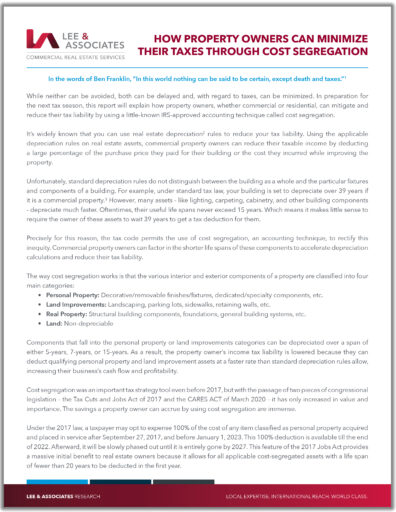In the words of Ben Franklin, “In this world nothing can be said to be certain, except death and taxes.”1
While neither can be avoided, both can be delayed and, with regard to taxes, can be minimized. In preparation for the next tax season, this report will explain how property owners, whether commercial or residential, can mitigate and reduce their tax liability by using a little-known IRS-approved accounting technique called cost segregation.
It’s widely known that you can use real estate depreciation2 rules to reduce your tax liability. Using the applicable depreciation rules on real estate assets, commercial property owners can reduce their taxable income by deducting a large percentage of the purchase price they paid for their building or the cost they incurred while improving the property.
Unfortunately, standard depreciation rules do not distinguish between the building as a whole and the particular fixtures and components of a building. For example, under standard tax law, your building is set to depreciate over 39 years if it is a commercial property.3 However, many assets - like lighting, carpeting, cabinetry, and other building components - depreciate much faster. Oftentimes, their useful life spans never exceed 15 years. Which means it makes little sense to require the owner of these assets to wait 39 years to get a tax deduction for them.
Precisely for this reason, the tax code permits the use of cost segregation, an accounting technique, to rectify this inequity. Commercial property owners can factor in the shorter life spans of these components to accelerate depreciation calculations and reduce their tax liability.
The way cost segregation works is that the various interior and exterior components of a property are classified into four main categories:
- Personal Property: Decorative/removable finishes/fixtures, dedicated/specialty components, etc.
- Land Improvements: Landscaping, parking lots, sidewalks, retaining walls, etc.
- Real Property: Structural building components, foundations, general building systems, etc.
- Land: Non-depreciable
Components that fall into the personal property or land improvements categories can be depreciated over a span of either 5-years, 7-years, or 15-years. As a result, the property owner’s income tax liability is lowered because they can deduct qualifying personal property and land improvement assets at a faster rate than standard depreciation rules allow, increasing their business’s cash flow and profitability. READ MORE >
DISCLAIMER: The content in this article is for informational purposes only, you should not construe any such information or other material as legal, tax, investment, financial, or other advice. Nothing contained herein constitutes a solicitation, recommendation, endorsement, or offer by Lee & Associates or any third party service provider.
All Content in this article is information of a general nature and does not address the circumstances of any particular individual or entity. Nothing in the article constitutes professional and/or financial advice, nor does any information constitute a comprehensive or complete statement of the matters discussed or the law relating thereto. You alone assume the sole responsibility of evaluating the merits and risks associated with the use of any information or other Content in the article before making any decisions based on such information or other Content.


